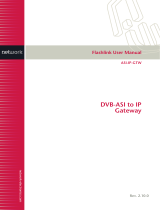
Introduction
DTV Monitors MPEG Transport Stream Monitor Programmer Manual
1−3
A MIB Module is defined in a text file using ASN.1 (Abstract Syntax Notation
One).
For more detailed explanations of network management using SNMP, you can
refer to The Simple Book: An Introduction to Internet Management (Marshall T.
Rose, Prentice Hall, ISBN 0-13-451659-1).
DTV Monitor SNMP Community
SNMP provides a simple mechanism for security, there are community strings to
govern read and write to the MIB; these function as passwords.
For the DTV Monitors, the community string “public” is used for read and write
access. It is possible to add a second community string. However, the “public“
access will still work.
DTV Monitor SNMP Traps
SNMP provides a mechanism for a device to send a notification message to the
management system when an event occurs. This means that the management
system can poll the device less often and so reduce network traffic.
The important point to note here is that it does not mean that the management
system can stop polling the device. Traps are sent using the UDP network
protocol. This mechanism does not guarantee arrival of all packets; a trap
message can be lost.
Trap messages may be lost not only in the UDP transport layer, but inside the
device. The DTV Monitors take steps to avoid flooding the network with traps;
this means some traps are discarded when there are a burst of errors in a stream.
A trap should be thought of as a prompt to visit the device to discover status
rather than a mechanism to completely know the status.
To prevent a flood of trap messages on a network, the DTV Monitors have a
throttling mechanism. A flood of trap messages is to be avoided since this could
hamper the operator’s ability to use the network to understand and contain an
error condition. In the extreme case a flood of trap messages could cause the
management system to fail.
On the DTV Monitor, a maximum number of trap messages per second is
defined. This is in total, so, if a limit of 10 per second is set, this will yield 5 per
second if two trap consumers are subscribed. Internally, there is a buffer for 100
traps so a short burst can be accommodated without losing messages. If the
buffer overflows, trap messages are discarded.
The implication of the preceding information is that network bandwidth, or trap
handling capability, is treated as a limited resource. To avoid wasting this





















